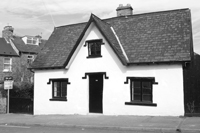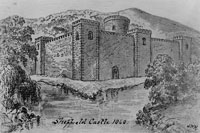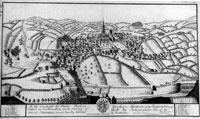Middle Ages The white house on Andover Street, possibly the oldest building in Burngreave  Artists impression of Sheffield Castle, surrounded by countryside in the Middle Ages  View of Sheffield from Burngreave by Thomas Oughtibridge, 1730 From 1100 to 1700 In the 1100s a local lord of the manor founded a hospital in the area, called St Leonards. Although there is no trace of it remaining, the name has been passed on to streets in the vicinity, called Spital Hill and Spital Lane (as in hospital). In the 1200s a Norman family called De Mounteney were prominent in the area and owned land around Shirecliffe and Grimesthorpe. In the 1400s and 1500s Burngreave was an area of open countryside with scattered farms, fields and woodland. The name Burngreave was first recorded in 1440 as Byron Greve, meaning Bryons Wood. This is shown in early maps on the site currently occupied by Burngreave Cemetery and along Burngreave Road. During the Tudor period Sheffield began to grow but Burngreave remained on the outskirts. Looking back from the top of Pitsmoor at that time, you would have seen rolling hills and farmland leading down to Ladys Bridge where a cluster of shops and houses had developed around the market place next to Sheffield Castle. On Andover Street there is a building which is thought to date back to Tudor times. Locally known as the White House, it operated as a fish and chip shop until recently. |

-
Burngreave Voices
- Map
- List View
- People
- Places
- History
- About the Project
- Your Memories
- Acknowledgements
- Copyright